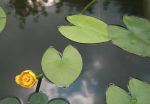 Also called brandy-bottle and spattercock, this aquatic deciduous perennial is a member of the Nymphaeaceae, a family of 75 specie of aquatic plants including and water lily. It is native to Europe, Asia, northwest Africa, eastern US, and the West Indies where it grows in ponds, stream sides, and slow moving water. From a large rhizome growing in the sediment, the plants send up separate shoots bearing either large leaves that float on the water or flowering stems with cup shaped yellow flowers. The flat leathery leaves are up to 16″ long and are heart-shaped with wavy margins. Smaller leaves attached to the rhizome may appear below the water surface. The greenish yellow flowers are 2″ across and have a brandy like fragrance that is unpleasant to some. The flowers half open in the morning and close at night for about 4-5 days from May to October before giving way to brandy-bottle shaped seedpods that burst when ripe like those of the dock plant, giving rise to the common names brandy-bottle and spatterdock. Plants die back to the rhizome in the fall. They are useful in ponds and large water gardens but spread quickly to form colonies and may need to be restrained. The genus name, Nuphar, is the Persian name for the plant. the specific epithet, lutea, is the Latin word meaning yellow and refers to the color of the flowers.
Also called brandy-bottle and spattercock, this aquatic deciduous perennial is a member of the Nymphaeaceae, a family of 75 specie of aquatic plants including and water lily. It is native to Europe, Asia, northwest Africa, eastern US, and the West Indies where it grows in ponds, stream sides, and slow moving water. From a large rhizome growing in the sediment, the plants send up separate shoots bearing either large leaves that float on the water or flowering stems with cup shaped yellow flowers. The flat leathery leaves are up to 16″ long and are heart-shaped with wavy margins. Smaller leaves attached to the rhizome may appear below the water surface. The greenish yellow flowers are 2″ across and have a brandy like fragrance that is unpleasant to some. The flowers half open in the morning and close at night for about 4-5 days from May to October before giving way to brandy-bottle shaped seedpods that burst when ripe like those of the dock plant, giving rise to the common names brandy-bottle and spatterdock. Plants die back to the rhizome in the fall. They are useful in ponds and large water gardens but spread quickly to form colonies and may need to be restrained. The genus name, Nuphar, is the Persian name for the plant. the specific epithet, lutea, is the Latin word meaning yellow and refers to the color of the flowers.
Type: aquatic deciduous perennial
Bloom: Greenish yellow cup shaped flowers from May to October
Size: 6-24″ H x 3-6′ W
Light: Full sun; tolerate some shade.
Soil: Wet
Hardiness: Zones 4-10
Care: Remove dead plant material as it forms to avoid fouling the water. Handle unwanted plant carefully to prevent unwanted spread because even small pieces of rhizome will produce new plants.
Pests and Diseases: None of significance
Propagation: Seed, division
Companion Plants: Lotus, water poppy, pickerel weed, water lily
Photo Credit: Wikimedia Commons